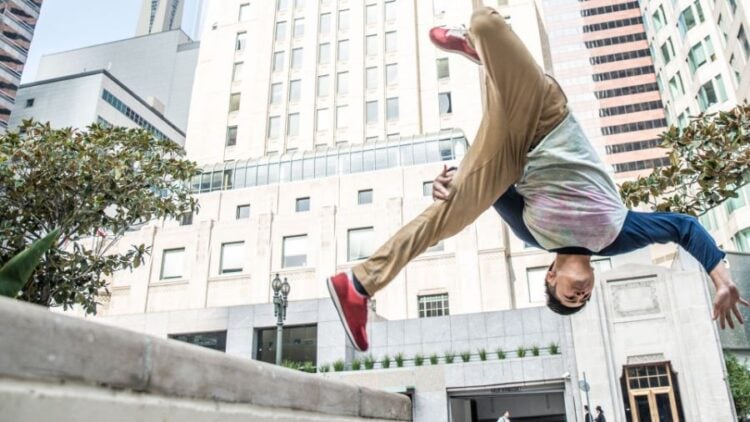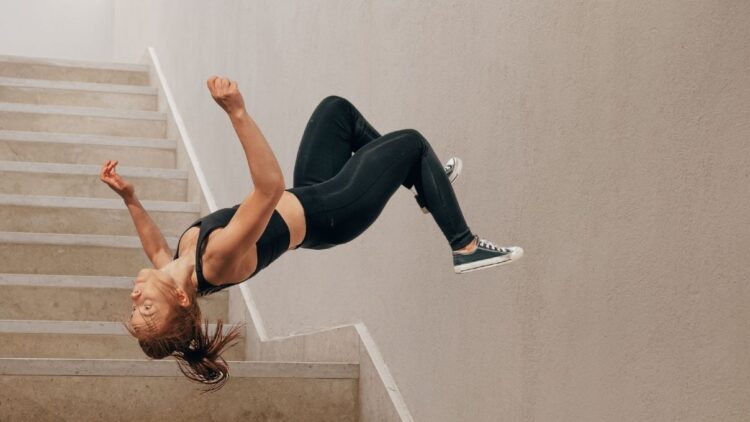
OBJECTIVE OF PARKOUR: Reach the finish line in the least amount of time possible OR score the most points by performing acrobatic tricks.
NUMBER OF PLAYERS: 1+ player(s)
MATERIALS: Comfortable clothing
TYPE OF GAME: Sport
AUDIENCE: No age requirement
OVERVIEW OF PARKOUR

Parkour, also called freerunning, is a form of athletic training in which competitors traverse various obstacles in an attempt to reach a destination as quickly as possible. This often includes many dangerous yet stylish stunts, such as climbing up walls, jumping between buildings, and swinging off of poles and railings. Essentially urban obstacle course racing, parkour could arguably be considered the on-foot equivalent of street skateboarding.
Activities that closely resemble parkour have been documented throughout history, especially among various African tribes and Chinese martial arts, which continues into modern times with big influences such as Bruce Lee. In the early 1900s, French naval officer Georges Hébert became increasingly intrigued by the athleticism of the indigenous African tribes he had met. This led to Hébert becoming a physical education instructor at the College of Reims in France, where he trained his students in “natural method” sessions, which included various, diverse forms of movement.
During World War II, a Swiss architect took inspiration from Hébert and developed a “parcours du combattant”, or a military obstacle course. Not only is this the origin of the name “parkour”, but this military course continues to be the basis on which civilian and military fitness courses are based. These courses were based of Hébert’s teaching of ten fundamental groups, which include running, climbing, and quadrupedal movement.
From these military courses, full of both mental and emotional obstacles, modern parkour was born. Raymond Belle was one of the personnel who used these courses, and continued his work in private. His son David Belle is often called the creator of parkour because he took his father’s training public.
While parkour has developed in many different areas of the world, it has remained chiefly a recreational activity. However, international parkour organizations, such as the World Freerunning and Parkour Federation, have begun forming as early as 2007. In 2017, parkour officially found its home as a gymnastics discipline after the International Gymnastics Federation planned a Parkour World Cup for the following year. Most recently, parkour was featured at the 2022 World Games.
What aided in Parkour’s competitive form was an MTV show called Ultimate Parkour Challenge, which still holds the record for largest viewership of a parkour event. Movies such as Casino Royale, have also pushed parkour and the parkour discipline into popularity
SETUP
EQUIPMENT
Parkour requires no specific equipment. In fact, most parkour practitioners prefer as little equipment as possible—no gloves, light-soled shoes, etc.—because it helps them “feel” the obstacles more, which aids in their balance and grip.
Equipment in parkour is very much a matter of preference. For example, some athletes prefer shoes with thick soles to better absorb the impact of their landings, while others strongly believe bare feet to be the most practical.
One this required is ever improving physical fitness, as some describe parkour as a physically testing sport.
EVENTS
WORLD BEST PARKOUR ATHLETES SPEED and STYLE COMPETITION
Parkour competitions can include nearly a dozen different kinds of events depending on the competition organizer. However, most events fit into one of two categories:
SPEED EVENTS
All speed events have the same goal of traversing an obstacle course from point A to point B in the least amount of time possible. Most speed events are time-based, meaning each competitor races by themself on the course one at a time. However, these events can also be done in a head-to-head format with competitors racing side-by-side on identical courses, in pairs with two athletes per team, or in a relay format.
STYLE EVENTS
Style events are where a competitor’s acrobatic and artistic talents can shine. In these events, athletes run along a course for a set period, using the obstacles to showcase their most impressive tricks. Athletes are scored based on a number of criteria that usually includes: difficulty, execution, versatility, and flow.
GAMEPLAY

SCORING
Speed events are determined based on which competitor is first to cross the finish line or finishes with the fastest time.
Style events are scored by a panel of three judges across four scoring categories: difficulty, execution, versatility, and flow.
While difficulty and execution are self-explanatory, the other two categories are in place to encourage athletes to use the entirety of the course, use a variety of moves, and find ways to “flow” their movements together with limited interruption.
In the style events, each competitor begins with a score of “0” in difficulty and versatility. Versatility points are awarded each time a competitor performs a trick in each section of the course. Difficulty points are awarded each time an athlete performs a new and difficult trick. For both categories, scores cap out at a maximum of 10 points.
Competitors also begin each style event with a maximum score of “10” in both execution and flow. Points are deducted from the execution score each time a mistake is made. Flow points are deducted every time the judges notice a “noticeable” period of inaction. For both of these scoring categories, a competitor can lose a maximum of all 10 points.
RULES
For the most part, there are very few rules in parkour competitions other than correctly following the course in speed events. However, parkour gets a bad rap as a recreational activity because of participants not just breaking the rules but also the law.
For starters, climbing on top of residential buildings and businesses can lead to trespassing violations. But, more importantly, parkour can also damage property, such as breaking pipes or just defacing property with scuff marks from shoes. While parkour athletes generally only put themselves in danger, if done irresponsibly, the sport can also be a danger to others. Parkour athletes have been known to perform tricks in public spaces where they could easily fall and accidentally injure bystanders.
Therefore, parkour athletes should always be mindful of where they’re allowed to practice and be aware of others in their parkour “course” to avoid costly legal troubles.
PARKOUR SAFETY
At its core, parkour is a rebellious, adrenaline-pumping sport. Parkour athletes scale walls, jump from roof to roof of high-rise buildings, and even jump and land from heights of over a dozen feet.
However, even the most extreme parkour athletes agree that safety always takes precedence. In fact, the entire purpose of the sport is for one to learn how to control themself in their environment. An athlete who seriously injures themself doing parkour is often blamed for not understanding their limitations.
In order to learn one’s limits, one must start pushing their limits, as contradictory as that sounds. To do this safely, people learning parkour should practice under the supervision of an experienced traceur (parkour athlete) and wear protective gear. With the guidance of a professional, an amateur athlete can quickly and safely learn how to progress from basic moves into the limit-pushing ones, breaking mental obstacles, that’ll help them reach their true potential.
END OF GAME
In parkour speed events, the winner is the athlete who crosses the finish line in the least amount of time.
In parkour style events, the winner is the athlete who scores the highest number of points from the judges.
- 30 GAMES TO PLAY OVER TEXT - April 22, 2024
- 20+ FREE PRINTABLE BABY SHOWER GAMES - April 16, 2024
- 20+ College Party Games for the Best Night Ever! - April 2, 2024